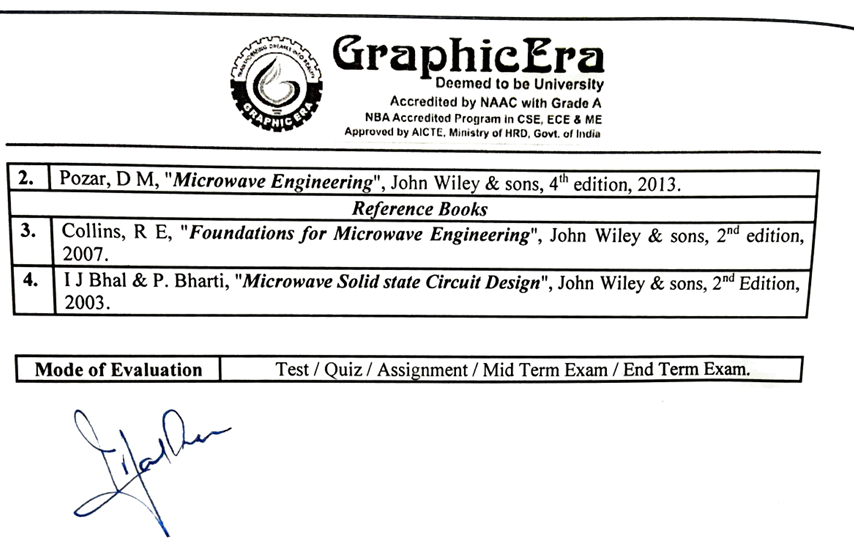SEMESTER VI
|
Sr. No. |
Department of Electronics and Communication Engineering |
||||||||
|
1. |
Subject Code |
TEC 602 |
Course Title |
Microwave Engineering |
|||||
|
2. |
Contact Hours |
L |
3 |
T |
0 |
P |
0 |
||
|
3. |
Examination Duration |
Theory |
03 |
Practical |
0 |
||||
|
4. |
Relative Weight |
CIE |
25 |
MSE |
25 |
ESE |
50 |
||
|
6. |
Credit |
03 |
|||||||
|
6. |
Semester |
Six |
|||||||
|
7. |
Category of Course |
DSC/PCC |
|||||||
|
8. |
Pre-requisite |
Communication Systems I(TEC 501), Communication Systems II (TEC 502), and Electromagnetic Field Theory(TEC 304) |
|||||||
|
9. |
Course Outcomes |
After completion of the course the students will be able to: CO1: Remember the basic concepts of waveguides and understanding of waveguides characteristics and cavity resonators. CO2: Analyse various microwave sources and their characteristics. CO3: Apply the basics of the waveguide to different microwave components based on network parameters. CO4: Understand various parameters measurement for evaluating the performance of the microwave components. CO5: Implement Microstrip filters used in RF transmitter and receiver. CO6: Design RF components, transmitter, receiver, and RF communication links. |

- Teacher: Anurag Vidyarthi
|
CO 1 |
Develop basic understanding of VLSI fabrication Technology. |
|
CO 2 |
Illustrate different kind of diffusion and deposition techniques in VLSI. |
|
CO 3 |
Discuss VLSI design concepts, MOS structure, and MOSFET equation in terms of current and voltage. |
|
CO 4 |
Examine the properties and characteristics of MOS structures. |
|
CO 5 |
Understand various layout and stick design of CMOS circuits. |
|
CO 6 |
Propose the characteristic differences in MOS structures and device-based projects. |
- Teacher: VINAY KUMAR
|
Department of Electronics and Communication Engineering |
|||||||
|
B. Tech in Electronics and Communication Engineering |
|||||||
|
Semester |
Sixth |
Subject Title |
Wireless Communication |
Code |
TEC 601 |
||
|
Course Component |
Credits |
Contact Hours |
L |
T |
P |
||
|
Professional Core Course (PCC) |
03 |
3 |
0 |
0 |
|||
|
Examination Duration (Hrs) |
Theory |
Weightage: Evaluation |
CWA |
MSE |
ESE |
||
|
03 |
25 |
25 |
50 |
||||
|
Pre-requisite: Communication Systems II |
|||||||
|
Course Outcomes |
|||||||
|
Upon completion of this course, the students will be able to |
|||||||
|
CO 1 |
Demonstrate an understanding on functioning of wireless communication system and evolution of different wireless communication systems and standards. |
||||||
|
CO 2 |
Demonstrate an understanding on cellular concepts, cellular architecture, and evolution of different generations and standards for mobile cellular communication. |
||||||
|
CO 3 |
Analyse and design of mobile radio propagation models. |
||||||
|
CO 4 |
Analyse different channel parameters, causes of impairments in signal propagation and impairment removal techniques. |
||||||
|
CO 5 |
Analyse different diversity combining techniques. |
||||||
|
CO 6 |
Apply the concepts of spread spectrum for designing wireless Communication Systems. |
||||||
|
|
|||||||
|
Unit No. |
Content |
Hours |
|||||
|
Unit 1: |
Wireless Communication System, Standards & Cellular Concept: An overview of wireless communication, Basic elements in wireless communication systems, Wireless communication system, and standards. Evolution of mobile cellular communication (1G, 2G. 2.5G, 3G and beyond), Typical cellular standards (AMPS, GSM, GPRS, WCDMA, LTE, LTE-A). Cellular concept – Frequency reuse – Channel assignment strategies – Handoff strategies – Interference & system capacity, Trunking & grade of service – Improving coverage and capacity in cellular system. |
10 |
|||||
|
Unit 2: |
Evolution of Mobile Radio Propagation Fundamentals: Large Scale Path Loss: Introduction to radio wave propagation, Free space propagation model, Basic propagation mechanisms, Ground reflection (Two-Ray) Model, Indoor propagation models, path loss model. |
7 |
|||||
|
Unit 3: |
Small Scale Fading & Multipath: Small-scale multipath propagation, Impulse response model of multipath channel, Parameters influencing small scale fading, Types of small-scale fading, Diversity mechanisms. |
9 |
|||||
|
Unit 4: |
Diversity Combining Techniques: Rayleigh &Rician fading models, Selection Combining (SC), Equal Gain Combining (EGC), and Maximal Ratio Combining (MRC), Derivation of SC, EGC, and MRC improvement, RAKE receiver. |
7 |
|||||
|
Unit 5: |
Spread spectrum: Multiple access techniques, Pseudo-noise sequence, Direct sequence spread spectrum (DS-SS), Frequency hopped spread spectrum (FHSS). Time hopping. |
7 |
|||||
|
Total Hours |
40 |
||||||
|
Textbooks |
|
|
1. |
Sanjay Kumar, “Wireless Communication: The Fundamental and Advanced Concepts”, River Publishers Series (Indian reprint), 1st Edition, 2015. |
|
2. |
Rappaport, T.S., “Wireless communications”, Pearson Education, India, 2nd edition, 2012. |
|
3. |
David Tse, Pramod Viswanath, “Fundamentals of Wireless Communication”, Cambridge University Press, 1st Edition, 2005. |
|
Reference Books |
|
|
4. |
T L Singal, “Wireless Communications”, Tata McGraw Hill Education India, 1st Edition,2014. |
|
5. |
Simon Haykin and Michael Moher, “Modern Wireless Communications”, Parson Education, 2nd Edition, 2005. |
|
6. |
Andrea Goldsmith, “Wireless Communications”, Cambridge University Press, 1st Edition, 2005. |
- Teacher: MD Irfanul Hasan

